
The Silver Age of Comic Books was a period of artistic advancement and widespread commercial success in mainstream American comic books, predominantly those featuring the superhero archetype. Following the Golden Age of Comic Books, the Silver Age is considered to cover the period from 1956 to 1970, and was succeeded by the Bronze Age.
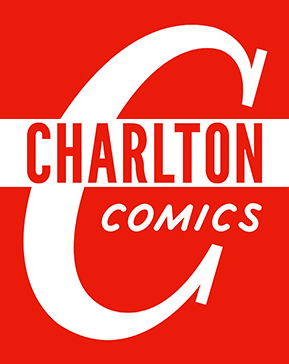
Charlton Comics was an American comic-book publishing company that existed from 1945 to 1986, having begun under a different name: T. W. O. Charles Company, in 1940. It was based in Derby, Connecticut. The comic-book line was a division of Charlton Publications, which published magazines, puzzle books, and briefly, books. It had its own distribution company.
Thor, the god of Norse mythology, has appeared as a character in various comics over the years, appearing in series from a range of publishers.
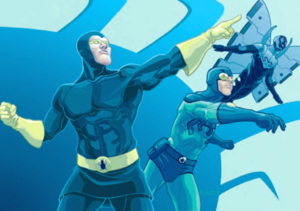
Blue Beetle is the name of three superheroes appearing in a number of American comic books published by a variety of companies since 1939. The most recent of the companies to own rights to Blue Beetle is DC Comics, which bought the rights to the character in 1983, using the name for three distinct characters over the years.

Peacemaker is the name of a series of fictional characters originally owned by Charlton Comics and later acquired by DC Comics. The original Peacemaker first appeared in Fightin' 5 #40 and was created by writer Joe Gill and artist Pat Boyette.
Black Fury is the name of several fictional comic book characters published in the Golden Age of Comics.
AC Comics is a comic book publishing company started by Bill Black.
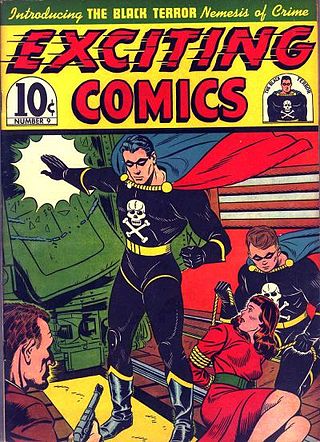
The Black Terror is a fictional comic book superhero who originally appeared in Exciting Comics #9, published by Nedor Comics in January 1941. The character was popular, and on the strength of the Black Terror's sales, Nedor made Exciting Comics a monthly magazine starting with issue #11.

The Shield is the name of several superheroes created by MLJ. Appearing months before Captain America, the Shield has the distinction of being the first superhero with a costume based upon United States patriotic iconography. The character appeared in Pep Comics from issue #1 to #65.

Daredevil is a fictional superhero created by Jack Binder, who starred in comics from Lev Gleason Publications during the 1930s–1940s period historians and fans call the Golden Age of comic books before being retroactively established into the Image Universe by Image Comics in the 1990s as its first character. The character is unrelated to Marvel Comics' Daredevil, and recent renditions of the character have often renamed him Doubledare or The Death-Defying Devil to avoid confusion and potential lawsuits.
"Charles Nicholas" is the pseudonymous house name of three early creators of American comic books for the Fox Feature Syndicate and Fox Comics: Chuck Cuidera (1915–2001), Jack Kirby (1917–1994), and Charles Wojtkoski (1921–1985). The name originated at Eisner & Iger, one of the first comic book packagers that created comics on demand for publishers entering the new medium during the 1930s–1940s Golden Age of comic books. The three creators are listed in order of birth year, below.

Mr. Muscles is a fictional comic book superhero created in 1956 by writer Jerry Siegel for Charlton Comics, and drawn by Bill Fraccio for the first of two issues of his namesake comic, and by the team of penciler Charles Nicholas and inker Vince Alascia for the second. A young Dick Giordano provided the premiere issue's cover. Siegel, who co-created Superman, wrote both issues featuring Charlton's own muscleman.
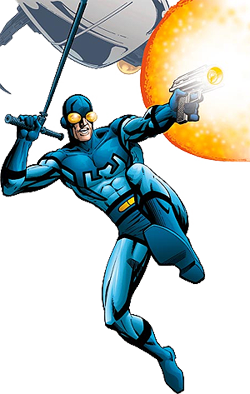
Theodore Stephen "Ted" Kord is the second Blue Beetle, a superhero who was originally published by Charlton Comics and later acquired by DC Comics. He was created by Steve Ditko and first appeared as a back-up feature in Captain Atom #83, with Gary Friedrich scripting from Ditko's conception and plot.

Jaime Reyes is a superhero appearing in American comic books published by DC Comics. Created by Keith Giffen, John Rogers, and Cully Hamner, the character made his first appearance in Infinite Crisis #3. Jaime Reyes is the third character to assume the mantle of Blue Beetle, but is substantially different from his predecessors.

The Fox is the name of two superheroes that appear in periodicals published by MLJ Comics and later Dark Circle Comics.
The Fantom of the Fair is one of the earliest published Golden Age superheroes. He debuted in Centaur Publications' Amazing Mystery Funnies vol. 2, #7, the overall 11th issue of that title. He premiered, according to cover dates, the same month as DC Comics' Sandman, Fox Publications' The Flame, and Centaur's Masked Marvel. He was created by Paul Gustavson, who had previously created the Arrow for Centaur.
The American Eagle is a superhero from the Golden Age of Comics. He first appeared in America's Best Comics #2, published by Nedor Comics, an imprint of Standard Comics.
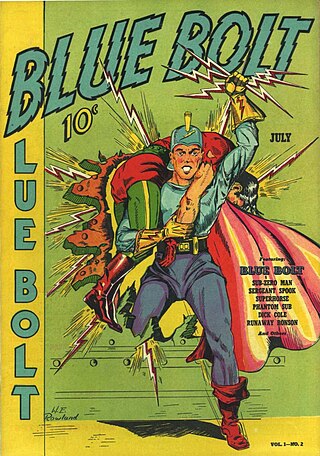
Blue Bolt is a fictional American comic book superhero created by writer-artist Joe Simon in 1940, during the period fans and historians refer to as the Golden Age of Comic Books.
Mystery Men Comics was an anthology American comic book series from the Golden Age of Comic Books published by Fox Feature Syndicate. The series was Fox's second title after the Wonderworld Comics series being first published in August 1939. The series would debut two superheroes in its first issue: the Green Mask and Dan Garret. The first issue was also notable for being one of the two comic book issues debuting John Tuska's work. The series would end in issue #31 in February 1942. Despite this and Fox's cancellation, the superhero Blue Beetle that the series help introduce would live on through Charlton and later DC Comics.

Blue Beetle is a long running comic book series featuring the superhero of the same name. Throughout its publication, the series has had three main characters who have each assumed the mantle of the Blue Beetle: Dan Garret, Ted Kord and Jaime Reyes. The series has been canceled and relaunched several times: its first volume was published by Fox Feature Syndicate and Holyoke Publishing, with subsequent volumes published by Charlton Comics and then DC Comics. Since 1986, the series and its characters have been integrated into the shared DC Universe.













